
This article relates to the flora of New Zealand, especially indigenous strains. New Zealand's geographical isolation has meant the country has developed a unique variety of native flora. However, human migration has led to the importation of many other plants as well as widespread damage to the indigenous flora, especially after the advent of European colonisation, due to the combined efforts of farmers and specialised societies dedicated to importing European plants & animals.

Knightia is a small genus of the family Proteaceae endemic to New Zealand, named in honor of Thomas Andrew Knight. One extant species, K. excelsa (rewarewa) is found in New Zealand. Two further Knightia species are found in New Caledonia, although they were placed in the genus Eucarpha by Lawrie Johnson and Barbara Briggs in their influential 1975 monograph "On the Proteaceae: the evolution and classification of a southern family", a placement supported in a 2006 classification of the Proteaceae. A fossil species from upper Miocene deposits in Kaikorai has been described as Knightia oblonga. Knightia has been placed in the tribe Roupaleae of the subfamily Grevilleoideae.
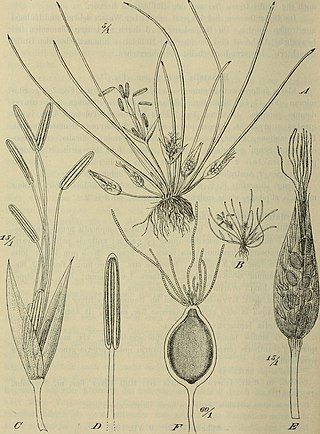
Hydatellaceae are a family of small, aquatic flowering plants. The family consists of tiny, relatively simple plants occurring in Australasia and India. It was formerly considered to be related to the grasses and sedges, but has been reassigned to the order Nymphaeales as a result of DNA and morphological analyses showing that it represents one of the earliest groups to split off in flowering-plant phylogeny, rather than having a close relationship to monocots, which it bears a superficial resemblance to due to convergent evolution. The family includes only the genus Trithuria, which has at least 13 species, although species diversity in the family has probably been substantially underestimated.
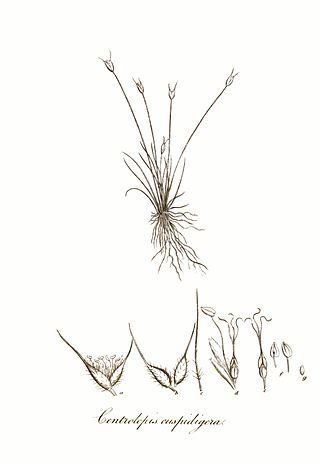
Centrolepidaceae was a family of flowering plants now included in Restionaceae following APG IV (2016). The botanical name has been recognized by most taxonomists.

Centrolepis is a genus of small herbaceous plants in the family Restionaceae known as thorn grass scales, with about 25 species native to Australia, New Zealand, New Guinea, and south-east Asia as far north as Hainan Dao. APG III system classifies this genus in the Centrolepidaceae family.

Libertia is a genus of monocotyledonous plants in the family Iridaceae, first described as a genus in 1824. It is native to South America, Australia, New Guinea, and New Zealand. Eight species are endemic to New Zealand.

Stylidium turbinatum is a dicotyledonous plant that belongs to the genus Stylidium. S. turbinatum is endemic to Australia and is found in the northern part of Western Australia in the Kimberley region and near Darwin in the Northern Territory. This species is an erect annual herb that stands 6–15 cm tall. A 2–5 cm long stem bearing scattered leaves terminate in a tuft of 1–2 cm long upper leaves. Several scapes appear from these terminal tufts. The inflorescence is a raceme, which produces pink flowers whose petals are vertically paired. The hypanthium of this species is turbinate and is one of the distinguishing characteristics used to identify it. The sepals form ribs around the hypanthium, giving it a turbine-like appearance. Seeds of S. turbinatum are pale orange and around 0.2 mm long. S. turbinatum was first formally described by Allen Lowrie and Kevin F. Kenneally in 1997, with most specimens having been collected and examined in the mid-1990s with one early specimen from 1990. S. turbinatum grows in sandy soils at the margins of creeks and floodways and is closely associated with wet season herb fields.

Trithuria is a genus of small ephemeral aquatic herb that represent the only members of the family Hydatellaceae found in India, Australia, and New Zealand. All 13 described species of Trithuria are found in Australia, with the exception of T. inconspicua and T. konkanensis, from New Zealand and India respectively. Until DNA sequence data and a reinterpretation of morphology proved otherwise, these plants were believed to be monocots related to the grasses (Poaceae). They are unique in being the only plants besides two members of Triuridaceae in which the stamens are centred and surrounded by the pistils; in Hydatellaceae the resulting 'flowers' may instead represent condensed inflorescences or non-flowers.
Kevin R. Thiele is currently an adjunct associate professor at the University of Western Australia and the director of Taxonomy Australia. He was the curator of the Western Australian Herbarium from 2006 to 2015. His research interests include the systematics of the plant families Proteaceae, Rhamnaceae and Violaceae, and the conservation ecology of grassy woodland ecosystems. He also works in biodiversity informatics, developing and teaching the development of interactive multi-access keys, and has been involved in the design of software for the Global Biodiversity Information Facility.
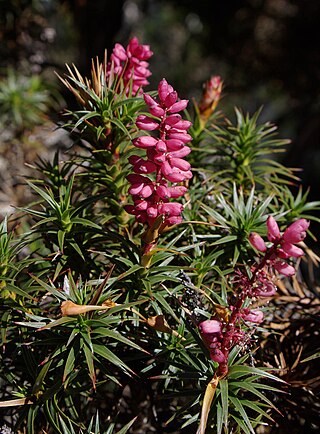
Richea scoparia is a species of plant endemic to Tasmania. The genus Richea, forms part of the Ericaceae family, which are commonly heath-like shrubs. The name refers to the erect bushy growth habit, described as a broom-like shrub, most commonly referred to as the honey bush or simply scoparia to many bushwalkers.
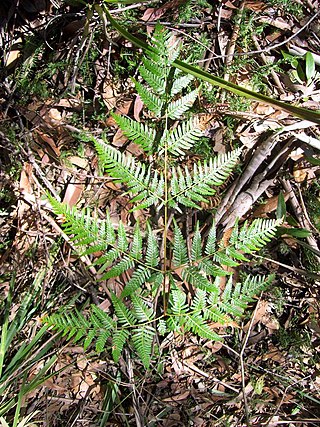
Pteridium esculentum, commonly known as bracken fern, Austral bracken or simply bracken, is a species of the bracken genus native to a number of countries in the Southern Hemisphere. Esculentum means edible. First described as Pteris esculenta by German botanist Georg Forster in 1786, it gained its current binomial name in 1908. The Eora people of the Sydney region knew it as gurgi.

Gaimardia is a genus of plants in the Restionaceae family. It has a disjunct distribution in New Zealand, New Guinea, Tasmania and extreme southern South America.
Centrolepis ciliata is a species of plant of the Restionaceae family. It is found in New Zealand.

Centrolepis pallida is a species of plant of the family Restionaceae. It is found in New Zealand.

Centrolepis strigosa, commonly known as hairy centrolepis, is a species of plant of the Restionaceae family. It is found in New Zealand and Australia

Pomaderris apetala is a small tree or large shrub from the family Rhamnaceae, growing in Victoria, New Zealand and Tasmania.
Adenanthos ellipticus, commonly known as the oval-leaf adenanthos, is a flowering plant from the family Proteaceae that is endemic to Western Australia where it is considered to be Declared Rare Flora.

Centrolepis fascicularis is a species of plant in the Restionaceae family.
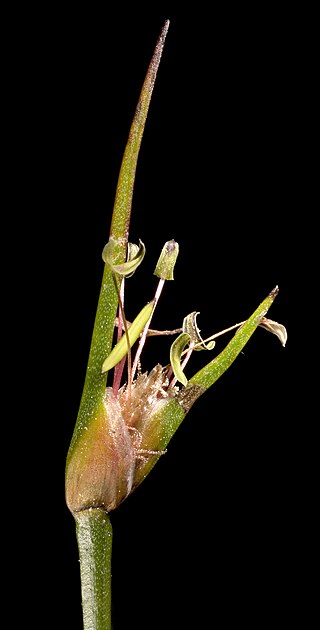
Centrolepis aristata, commonly known as pointed centrolepis, is a species of plant in the Restionaceae family and is found in areas of southern Australia.
Petalophyllum, or petalwort, is a genus of liverworts in the order Fossombroniales.















